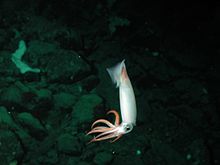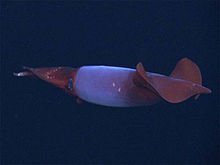Gonatidae
| Gonatidae Temporal range:
| |
|---|---|

| |
| Berryteuthis magister | |
| Scientific classification | |
| Domain: | Eukaryota |
| Kingdom: | Animalia |
| Phylum: | Mollusca |
| Class: | Cephalopoda |
| Order: | Oegopsida |
| Family: | Gonatidae Hoyle, 1886[2] |
| Type genus | |
| Gonatus Gray, 1849
| |
| Genera | |
The Gonatidae, also known as armhook squid, are a
Description

Morphologically, armhook squid are fairly uniform: all species are characterised by the suckers of their
Only one species, the fiery armhook squid (Gonatus pyros), possesses photophores; these are located on the ventral periphery of the eyes.
Gonatids typically have muscular, cylindrical bodies with very soft, reddish to purplish-brown skin. The arms are thick and capable; the fins vary in shape and size, from sagittate and about 50% of the mantle length, to reniform and about 30% of the mantle length. Of moderate size, these squid range in size from 11 to 40 cm—most species are 25 cm or less. Females are somewhat larger than males.
Life history


These squid are pelagic, associated with the continental shelf and may roam as deep as 4,500 m or more, depending on the species. Their habits are poorly studied, but the squid are thought to undertake diel migration; by day, the squid remain in the blackness of the depths in midwater. By night, they ascend to the upper layers of the water column to feed by starlight. One species, however, Gonatopsis octopedatus, has curiously recurved arms, suggesting a benthic existence.
Little is known about the reproductive cycle of armhook squid. Most squid species whose reproduction has been observed have been seen to deposit eggs on the sea floor, then leave the eggs to hatch on their own. Five female Gonatus onyx squids have been observed in Monterey Canyon dragging a membrane sack containing 2,000 to 3,000 developing eggs.[5] It is uncertain if this behavior extends to other members of the family Gonatidae or if it is particular to this species.
Prey items include both
Species
- Genus Berryteuthis
- Berryteuthis anonychus, minimal armhook squid
- Berryteuthis magister
- Berryteuthis magister magister, magister armhook squid
- Berryteuthis magister nipponensis
- Berryteuthis magister shevtsovi
- Genus Gonatopsis
- Subgenus Boreoteuthis
- Gonatopsis borealis, boreopacific armhook squid
- Subgenus Gonatopsis
- Gonatopsis japonicus
- Gonatopsis makko, Makko armhook squid
- Gonatopsis octopedatus
- Gonatopsis okutanii *
- Subgenus Boreoteuthis
- Genus Gonatus
- Gonatus antarcticus
- Gonatus berryi, Berry armhook squid
- Gonatus californiensis, California armhook squid
- Gonatus fabricii, boreoatlantic armhook squid
- Gonatus kamtschaticus
- Gonatus madokai, Madokai armhook squid
- Gonatus onyx, clawed armhook squid or black-eyed squid
- Gonatus oregonensis, Oregon armhook squid
- Gonatus pyros, fiery armhook squid
- Gonatus steenstrupi, Atlantic armhook squid
- Gonatus ursabrunae, brown bear armhook squid
The species listed above with an asterisk (*) is questionable and needs further study to determine if it is a valid species or a synonym.
References
- ^ "Statoliths of Cenozoic teuthoid cephalopods from North America | The Palaeontological Association". www.palass.org. Retrieved 2023-10-09.
- ^ Julian Finn (2016). "Gonatidae Hoyle, 1886". World Register of Marine Species. Flanders Marine Institute. Retrieved 4 March 2018.
- ISBN 978-92-5-106720-8.
- ^ Kubodera, Tsunemi; F. G. Hochberg; Richard E. Young & Michael Vecchione (2014). "Eogonatus Nesis, 1972". Tree of Life Web Project. Retrieved 4 March 2018.
- PMID 16355206.
- . Retrieved 2021-03-02.
External links
- CephBase: Gonatidae
- Tree of Life web project: Gonatidae
- Gonatidae discussion forum at TONMO.com
- Small-clawed armhook quid subduing and killing an owlfish video from the Monterey Bay Aquarium Research Institute.
- "Video of Gonatus onyx with egg sacs". Science News. Archived from the original (MPEG) on March 10, 2006. Retrieved September 26, 2006.
